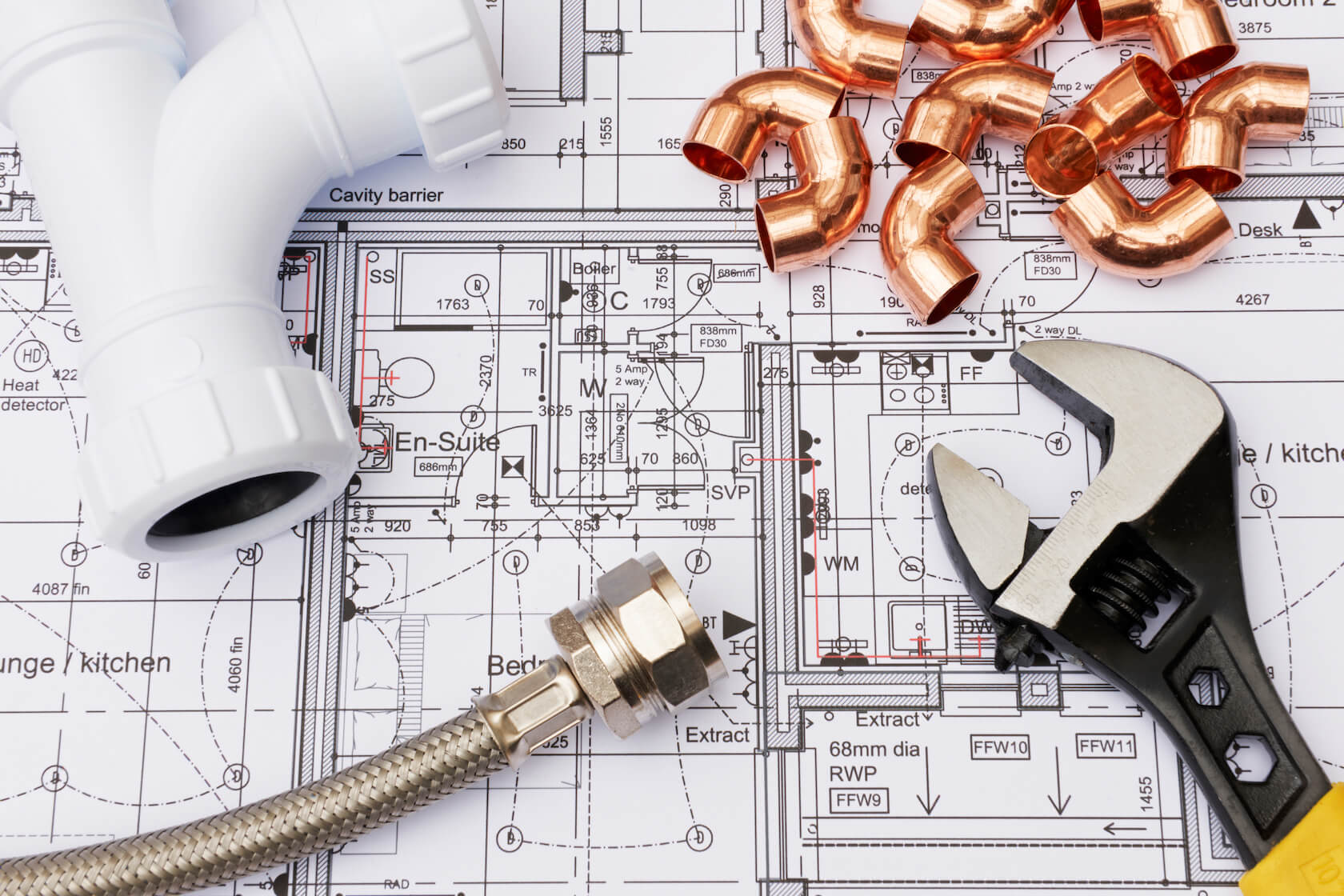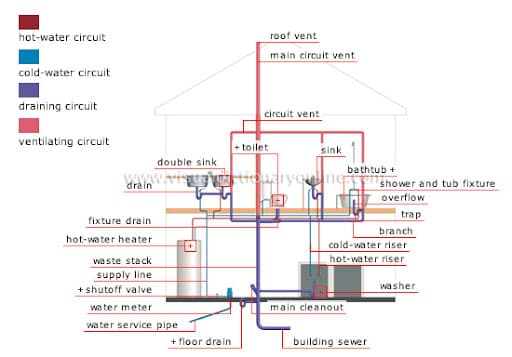We've noticed this post involving Anatomy of a House: Understanding the Components down the page on the web and concluded it made perfect sense to relate it with you on my blog.

Comprehending just how your home's pipes system works is crucial for every single property owner. From supplying clean water for alcohol consumption, food preparation, and showering to securely removing wastewater, a well-kept plumbing system is vital for your family's health and comfort. In this detailed guide, we'll discover the intricate network that makes up your home's plumbing and offer suggestions on maintenance, upgrades, and managing usual issues.
Introduction
Your home's plumbing system is greater than simply a network of pipelines; it's a complex system that guarantees you have access to clean water and efficient wastewater removal. Understanding its parts and just how they work together can aid you prevent pricey fixings and make sure everything runs smoothly.
Basic Parts of a Pipes System
Pipelines and Tubing
At the heart of your plumbing system are the pipelines and tubes that lug water throughout your home. These can be constructed from different products such as copper, PVC, or PEX, each with its benefits in regards to toughness and cost-effectiveness.
Components: Sinks, Toilets, Showers, and so on.
Components like sinks, toilets, showers, and bathtubs are where water is used in your house. Recognizing just how these components link to the pipes system assists in identifying issues and preparing upgrades.
Shutoffs and Shut-off Points
Valves manage the flow of water in your plumbing system. Shut-off shutoffs are critical during emergencies or when you need to make repairs, permitting you to separate parts of the system without interfering with water flow to the entire house.
Supply Of Water System
Main Water Line
The main water line attaches your home to the metropolitan water or a personal well. It's where water enters your home and is distributed to various components.
Water Meter and Stress Regulatory Authority
The water meter procedures your water usage, while a pressure regulatory authority makes certain that water moves at a risk-free pressure throughout your home's plumbing system, protecting against damages to pipelines and fixtures.
Cold Water vs. Hot Water Lines
Recognizing the difference between cold water lines, which supply water straight from the major, and hot water lines, which carry warmed water from the hot water heater, helps in repairing and preparing for upgrades.
Drain System
Drain Piping and Traps
Drain pipelines carry wastewater away from sinks, showers, and commodes to the drain or septic tank. Catches stop sewer gases from entering your home and likewise trap particles that might cause obstructions.
Air flow Pipes
Air flow pipes allow air right into the drain system, preventing suction that can slow down water drainage and trigger traps to vacant. Appropriate air flow is necessary for maintaining the honesty of your plumbing system.
Importance of Appropriate Drainage
Making certain appropriate water drainage prevents back-ups and water damages. Frequently cleansing drains and preserving catches can avoid pricey repair work and expand the life of your plumbing system.
Water Furnace
Types of Hot Water Heater
Water heaters can be tankless or standard tank-style. Tankless heaters heat water as needed, while tanks save heated water for instant use.
Exactly How Water Heaters Attach to the Plumbing System
Comprehending just how water heaters attach to both the cold water supply and hot water distribution lines aids in diagnosing issues like not enough warm water or leakages.
Maintenance Tips for Water Heaters
Frequently flushing your hot water heater to remove sediment, inspecting the temperature level settings, and examining for leakages can extend its life expectancy and boost energy effectiveness.
Usual Pipes Issues
Leaks and Their Causes
Leaks can take place as a result of aging pipes, loose installations, or high water stress. Addressing leaks immediately protects against water damage and mold growth.
Blockages and Clogs
Obstructions in drains pipes and toilets are frequently triggered by purging non-flushable things or a build-up of grease and hair. Using drain displays and bearing in mind what drops your drains pipes can prevent clogs.
Signs of Plumbing Issues to Look For
Low tide stress, slow-moving drains, foul odors, or unusually high water bills are indications of potential plumbing problems that should be addressed promptly.
Plumbing Maintenance Tips
Regular Evaluations and Checks
Arrange annual plumbing inspections to catch issues early. Try to find indications of leakages, corrosion, or mineral buildup in faucets and showerheads.
DIY Maintenance Tasks
Easy tasks like cleaning faucet aerators, looking for commode leakages making use of color tablet computers, or protecting exposed pipes in cool environments can protect against significant pipes problems.
When to Call an Expert Plumbing Technician
Know when a pipes problem requires specialist experience. Trying intricate fixings without appropriate understanding can lead to even more damages and greater repair service expenses.
Upgrading Your Pipes System
Factors for Updating
Upgrading to water-efficient components or changing old pipes can improve water quality, lower water costs, and boost the value of your home.
Modern Plumbing Technologies and Their Advantages
Check out innovations like clever leakage detectors, water-saving bathrooms, and energy-efficient water heaters that can save money and reduce environmental influence.
Price Factors To Consider and ROI
Determine the in advance expenses versus long-term financial savings when considering pipes upgrades. Several upgrades spend for themselves with minimized utility costs and less repair services.
Environmental Impact and Preservation
Water-Saving Fixtures and Appliances
Mounting low-flow faucets, showerheads, and commodes can substantially reduce water use without compromising performance.
Tips for Lowering Water Use
Simple behaviors like fixing leakages quickly, taking much shorter showers, and running full lots of washing and dishes can save water and lower your energy bills.
Eco-Friendly Pipes Options
Consider lasting pipes materials like bamboo for flooring, which is durable and eco-friendly, or recycled glass for counter tops.
Emergency situation Preparedness
Actions to Take During a Pipes Emergency situation
Know where your shut-off valves lie and how to shut off the water supply in case of a burst pipeline or major leakage.
Significance of Having Emergency Situation Get In Touches With Convenient
Keep call details for local plumbing professionals or emergency situation services easily available for quick feedback during a pipes situation.
DIY Emergency Fixes (When Relevant).
Temporary repairs like making use of duct tape to patch a dripping pipeline or placing a container under a trickling tap can minimize damage till a specialist plumbing professional arrives.
Final thought.
Understanding the anatomy of your home's plumbing system equips you to keep it properly, saving time and money on repair services. By adhering to normal maintenance routines and remaining educated regarding modern-day plumbing innovations, you can guarantee your plumbing system operates successfully for years to find.
HOW YOUR PLUMBING SYSTEM WORKS
Which Pipes Do What?
Blue lines = fresh water supply entering the building
Red lines = hot water supply entering the building
Grey lines = pipes carrying waste away from the building and venting pipes carrying gases away from the building (through the roof)
YOUR MAIN PLUMBING SYSTEMS
There are two main plumbing systems that support your home s basic plumbing needs one that brings clean water into your home, and one that sends dirty water away from your home. Connected to the toilet, bath, shower, and other faucets in your home, these two systems keep your water flowing in the right directions.
ACCESSING FRESH WATER
Fresh and clean water is brought into your home through the main water supply line . Filtered through one pipe, this water is pressured to flow into the various fixtures in your home at any given time.
This water can be sourced from a well located on your property, a pond or river (mostly cottages), or, as in most cases, from the city s municipal water treatment centre. However, it is important to note that water that is untreated, such as the water siphoned from ponds or rivers, may not be safe to drink. Personal water supplies always need to be treated for hardness and contaminants before consumed.
MUNICIPAL WATER SUPPLIES
Improve taste and odour
Remove sediment
Eliminate hardness
Reduce chlorine
COLD WATER SUPPLY VS. HOT WATER SUPPLY
Cold water flows into your home or building through the service line, which then distributes hot or cold water to your fixtures. This line is most commonly run through a central column that runs floor to floor. Hot water runs in short and straight pipes as the longer the pipeline, the more heat that will be lost in the transfer. Having shorter pipes also allows residents to access hot water more quickly.
WASTE WATER SYSTEM
Your wastewater system is divided into two parts pipes that send wastewater away from your home and venting pipes that send sewer gas away from your home. Sewage water travels through pipes that flush the water and waste towards local sewers that are operated and managed by your city or town. Most sewer systems rely on gravity to move the wastewater to where it needs to go.
The further away from your toilet or sink, the larger wastewater pipes become. This allows for waste to be disposed of from various parts of your home or business at once without pipe blockages. The angle and flow of these pipes are also essential for keeping your waste pipes clear of build up.
https://harrisplumbing.ca/how-your-home-plumbing-system-works/

HOW YOUR PLUMBING SYSTEM WORKS
Which Pipes Do What?
YOUR MAIN PLUMBING SYSTEMS
There are two main plumbing systems that support your home s basic plumbing needs one that brings clean water into your home, and one that sends dirty water away from your home. Connected to the toilet, bath, shower, and other faucets in your home, these two systems keep your water flowing in the right directions.
ACCESSING FRESH WATER
Fresh and clean water is brought into your home through the main water supply line . Filtered through one pipe, this water is pressured to flow into the various fixtures in your home at any given time.
This water can be sourced from a well located on your property, a pond or river (mostly cottages), or, as in most cases, from the city s municipal water treatment centre. However, it is important to note that water that is untreated, such as the water siphoned from ponds or rivers, may not be safe to drink. Personal water supplies always need to be treated for hardness and contaminants before consumed.
MUNICIPAL WATER SUPPLIES
COLD WATER SUPPLY VS. HOT WATER SUPPLY
Cold water flows into your home or building through the service line, which then distributes hot or cold water to your fixtures. This line is most commonly run through a central column that runs floor to floor. Hot water runs in short and straight pipes as the longer the pipeline, the more heat that will be lost in the transfer. Having shorter pipes also allows residents to access hot water more quickly.
WASTE WATER SYSTEM
Your wastewater system is divided into two parts pipes that send wastewater away from your home and venting pipes that send sewer gas away from your home. Sewage water travels through pipes that flush the water and waste towards local sewers that are operated and managed by your city or town. Most sewer systems rely on gravity to move the wastewater to where it needs to go.
The further away from your toilet or sink, the larger wastewater pipes become. This allows for waste to be disposed of from various parts of your home or business at once without pipe blockages. The angle and flow of these pipes are also essential for keeping your waste pipes clear of build up.
https://harrisplumbing.ca/how-your-home-plumbing-system-works/
I was shown that write-up about Exploring Your Homes Plumbing Anatomy through a good friend on our other site. Liked our blog entry? Please share it. Help somebody else discover it. Thank you so much for your time invested reading it.
Click Here